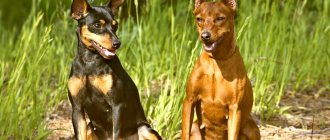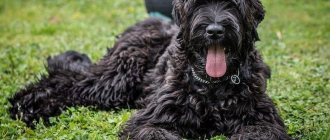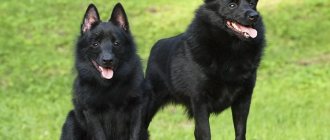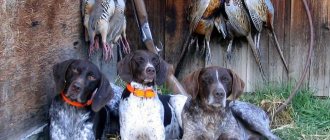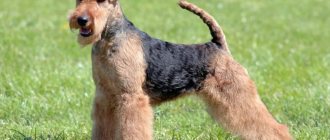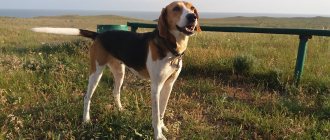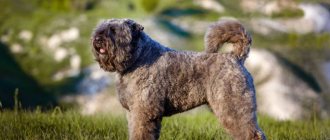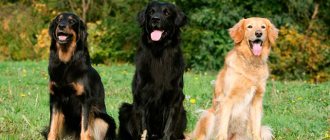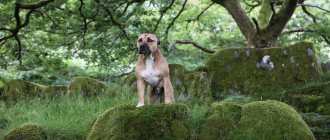Origin story
Now it is not known exactly where the Chinese Crested was bred, despite its name. Presumably, it was Mexico or Africa, but the breed was approved for the first time in England. In 1966, several individuals of a species that was almost lost at the beginning of the twentieth century were brought there. The first standards were developed there.
Presumably at the beginning of the sixteenth century, the breed was bred somewhere in Mexico, and later it came to Chinese sailors. On ships, agile small dogs dealt with rodents. For a long time, crested animals were very popular and mystical properties were even attributed to them, but over time they almost disappeared in China. How this happened and what really happened - experts are still arguing.
Chinese Crested Dog: Breed Standard
According to the standard, hair is found only on the head, paws and tail, and the rest of the body is bare. But there are also downy individuals - long-haired, with silky fur and dense undercoat. It is curious that both species are unpredictably born in the same litter.
The average weight of the breed is about 4-5 kg with a height at the withers of up to 33 cm. The color of the coat is not standardized so strictly and can be anything. The head is round, slightly elongated and very graceful, with a pronounced transition from the forehead. It always has a crest, which is why the breed got its name.
The tip of the nose is any color, but the eyes are always almost black and widely spaced, with barely noticeable white. Large ears are set low, the neck is dry and long, with a beautiful bend in movement. With external fragility, the jaw is strong and strong. The tail is long, set high, but carried down and tapering to the tip.
Appearance[edit | edit code]
Chinese Crested Dog
The head of the Chinese Crested Dog has a slightly rounded and elongated skull, with a very graceful shape. The muzzle is flat, tapering towards the nose. The transition from the forehead to the muzzle is smoothed, not sharply defined. The length of the head from the back of the head to the beginning of the muzzle should be the same as from the nose to the beginning of the muzzle. The muzzle itself should not be loose, the lips should fit tightly. According to the breed standard, the nose can be any color. The peculiarity of the breed is the presence of a crest on the head, thanks to which the dog got its name. The crest starts from the beginning of the transition from the forehead to the muzzle and ends on the neck; it can be either not very long or very flowing, which is more preferable for this breed.
The eyes are very dark, almost black, like olives. The iris occupies almost the entire eye, the white is almost invisible. The eyes are of medium size, widely spaced, the disadvantage is close-set, light-colored eyes.
The ears should be set low and in line with the outer corner of the eye. The ears are erect, large, and may or may not have fringe. The downy type of Chinese Crested Dog may have floppy ears. A disadvantage in both varieties of the breed is the ears, which stand on semi-cartilages.
Despite its small size and apparent defenselessness, the Chinese Crested Dog has strong and strong jaws, and the dental system has a scissor bite. Hairless dogs have different teeth than other dog breeds. Here, a lack of teeth is acceptable and these anomalies are not a defect or a disqualifying sign. Reduced canines, practically no different from incisors, are also acceptable. The fangs may look like tusks due to their forward direction. This feature of the dental system is characteristic of only hairless dogs.
The breed is characterized by a dry and long neck; any dewlap or thickening is not allowed. When the dog moves, the neck is held high and beautifully arched. The animal's shoulders are strong, with very developed prominent muscles.
Downy Chinese Crested
The forelimbs are slender and long, the elbows should not be spread apart, they fit snugly to the body. The hind limbs are set wide, the thighs are strong and elastic, the shins are long, and the hocks are low. The paws are hare-shaped, they are long and narrow, the wrist bones are miniature and elongated. According to the breed, the toes on the paws should be covered with elongated hair, which should not extend onto the wrists. The paws are straight-set; turning to any side is a disadvantage.
The tail is set high, very long, tapering towards the end. It should not be bent, and if the animal is not excited, it should be in a downward position. At the end of the tail there should be a long, flowing tassel that ideally covers two-thirds of the entire length of the tail. The disadvantage is the short tail, which does not reach the hock joints of the hind legs, and the tail without a tassel.
The coat should not be thick and cover large areas of the dog's body. The animal's skin is soft, elastic and warm. In the hairless form of the breed, the dog has a smooth body not covered with hair; hair can only be on the head, on the tip of the tail and on the paws. If the dog is downy, then its coat does not consist of undercoat, but only of the outer coat. A distinctive feature of the breed is the veil-like coat, which falls to a fairly large length[2].
Personality of the Chinese Crested
Chinese Cresteds are not hunters, guard dogs, or service dogs. They were bred specifically to please their owner and become a loyal and devoted friend. So the character of well-mannered dogs is very soft, restrained and flexible.
Traits and Temperament
Although Chinese Cresteds seem very sweet and loving, without proper training they become unmanageable. They can bark at strangers and even bite, they behave badly when walking, they are capricious and destroy everything around them. To prevent this from happening, the dog will have to pay a lot of attention.
Attitude towards the owner
Chinese Cresteds adore their owners and can even become companions for people with disabilities. Although they are friendly to strangers, they only really treat their family with love. For the same reason, they have a hard time experiencing a long separation.
Attitude towards children
The four-legged friend will be a good companion for small children, because she is very friendly and patient. Chinese Cresteds are very active and love to play, so no one will get bored. And later they will willingly teach commands and tricks to schoolchildren. But be sure to teach your child how to handle the fragile little dog with care.
Relationships with other animals
Chinese Cresteds can get along with literally everyone – including animals. They are not conflicting at all, so practically no problems arise.
Caring for a Chinese Crested
A specific breed requires truly specific care. You don't need any special skills, but you definitely need patience and a willingness to take care of your pet!
Conditions of detention
At home, Chinese Cresteds often appear lazy and phlegmatic. But this is just an illusion, so make sure your pet has toys. Hairless dogs are sensitive to cold, drafts and direct sun, so place the dog bed somewhere secluded.
Hygiene
Even a hairless crested cat needs to be carefully combed so that the long hair does not get tangled. Naturally, downy ones need this even more often. If this is not done, the old coat will become matted, because the breed hardly sheds.
Hairless Cresteds are washed 2-3 times a week with mild dog products, otherwise this can lead to skin problems. Apply softening and moisturizing creams against irritation and peeling. But take only specialized veterinary cosmetics, otherwise allergies may occur.
Chinese Cresteds constantly have problems with their teeth, so they need to be cleaned and examined regularly. In the same way, periodically check your eyes and ears, and once a year we recommend contacting specialists for a professional examination. Nails need to be trimmed several times a month.
Walks
Like many small dogs with good appetites, Chinese Cresteds are prone to excess weight, so they need active walks. Moreover, they love to play outside and dig in the ground. The favorite pastime of many pets is to find a toy that the owner had previously buried.
Surprisingly, decorative babies are amazingly jumping and easily overcome fences of a meter and a half. Keep in mind that on hot summer days you will have to avoid the scorching aggressive sun, and in winter you will need clothing. Some owners even use sunscreen.
Education and training
Chinese Cresteds do not require strict training, but they do need education. This determines how the pet will behave at home and during walks. The first step is to learn basic commands, forms of prohibition and not allow your pet to grab everyone’s legs.
Proper care and maintenance
Keeping crested Chinese does not imply anything extraordinary. The breed needs personal space to sleep, eat, and perform its natural needs. For visits to the veterinary clinic, as well as long journeys, a carrying bag is very useful. Experienced owners recommend that from a very early age you accustom your pet to walking equipment (a collar, or better yet a harness, a leash-roulette), and a wardrobe from bad weather (a dog’s lush, thick fur coat does little to protect it from the cold). To prevent the family favorite from getting bored, toys (store-bought squeakers, traffic jams, balls, balls) will come in handy.
Grooming
Caring for and caring for a Chinese Crested will require a lot of effort from the owner. The bare skin of crested cats requires no less attention than the lush fur of powder puffs. Hairless dogs are bathed twice a week using a mild shampoo. The delicate skin of corydalis is very sensitive and prone to inflammation: treatment with nourishing, moisturizing creams is a good solution for the prevention of dermatitis.
Sparse hairs on the belly of hairless corydalis spoil the toned silhouette. To bring the exterior to perfection, dogs are subjected to a depilation procedure (with a razor or depilatory cream).
Powder puffs are bathed less often than puffs, but puffs require daily combing. The Chinese Corydalis is famous for its soft, delicate fur - irregular combing and unprofessional care will inevitably lead to the formation of tangles. It is better to accustom your pet to hygienic haircuts (trimming split ends, refining the contours of the crest, framing the muzzle) from the first days of moving from the kennel.
Standard hygienic grooming procedures are simple; caring for a Chinese Crested is accessible even to a novice owner:
- care for the funnel of the ears;
- treat the mucous membranes of the eyes with veterinary lotion;
- trimming claws;
- take care of your mouth and teeth.
What to feed your Chinese Crested
Due to constant problems with teeth and joints, it is best to feed the Chinese Crested with specialized food, and hypoallergenic. Often you have to switch to soft canned food if your teeth are really bad. For the same reason, they need supplements with vitamins A, E, D, calcium and phosphorus.
A natural diet will require a lot of protein - fish, lean meat, eggs and dairy products. Dilute them by a third with cereals and vegetables and add very little fat for the skin and coat. Puppies can be fed 5-6 times in small portions, and adults need 2 feedings after walks.
Avoid pork, fatty and spicy foods, bones and raw fish, smoked meats, exotic fruits and vegetables. Do not give pasta, cabbage, potatoes and legumes. Sensitive and allergy-prone pets are prohibited from sweets, baked goods and milk.
Health and disease of the breed
The most common problems in Chinese Cresteds are dental diseases. Watch the diet, give vitamins, regularly take your pet to procedures and examinations. It happens that by the age of two years, otherwise healthy dogs have almost no teeth left.
They are also characterized by typical problems of small breeds - dislocations and other joint disorders. Here again, vitamins, healthy eating and control are important. Chinese crested dogs also have increased sensitivity to various medications, food and external irritants. They are prone to severe allergic reactions.
Is it worth it for a family with small children?
Look at a photo of a Chinese Crested Dog and you will notice how fragile this creature is. In reality, this is true: if you carelessly sit on an animal or touch it with something heavy, you can cause serious injury.
Therefore, it is not recommended to have such pets in families with small children. The baby, without realizing it, can harm the animal.
Chinese Crested Dog - photo
The Chinese Crested is undoubtedly one of the most recognizable dog breeds because it is simply impossible to confuse it with others. But just look how cute they are!
Combing and other types of care
The coat needs to be brushed daily, especially if it is long. This will help avoid the formation of tangles. It is better to ask the breeders about how to cut a Chinese Crested dog.
There are separate rules for show animals: when working with them, special clippers, trimmers, and hairdressing scissors are used.

